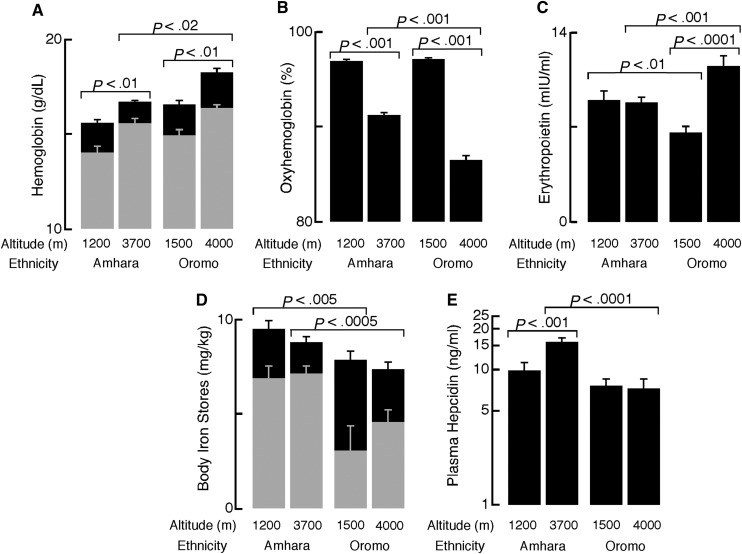Figure 1.
Oxyhemoglobin percentage, hemoglobin, ferritin, hepcidin, and erythropoeitin of Ethiopians differ by ethnicity at high and low altitudes. A total of 116 high-altitude Amhara (27 females, age 32 ± 0.8 years), 49 low-altitude Amhara (9 females, 34 ± 1.4 years), 75 high-altitude Oromo (27 females, 28 ± 1.0 years), and 39 low-altitude Oromo (6 females, 25 ± 0.9 years) were included in the analyses. Data were analyzed using the JMP 9 statistical software (SAS Institute, Cary, NC). Data are reported as mean and standard error of the mean. (A) Hemoglobin was higher in men (black) compared with women (gray) in all populations (all P < .005). Hemoglobin was increased at high altitudes in both ethnic groups, but Oromo had higher hemoglobin than Amhara at high altitudes. Hemoglobin concentration was measured using the cyanmethemoglobin technique (Hemocue, Sweden) immediately after drawing venipuncture samples. (B) Oxyhemoglobin percentage was significantly lower among Ethiopians at high altitude compared with low altitudes. At high altitude (3700-4000 m), Oromo had significantly lower saturations than Amhara. (C) Amhara had no altitude differences in erythropoietin, whereas Oromo had significantly higher erythropoietin at high vs low altitude. Compared with the Oromo, Amhara had lower erythropoietin at high altitude and higher erythropoietin at similar low altitudes. Erythropoietin was measured in serum by ELISA (R&D Systems, Minneapolis, MN). Extreme outliers (EPO > 40 mIU/mL) were excluded in advance of statistical testing. (D) Body iron stores were significantly lower among women (gray bars) compared with men (black bars) except among low-altitude Amhara (all others, P < .01). Neither Amhara nor Oromo had altitude differences in body iron stores. At high altitudes, Amhara had higher body iron stores than Oromo. Body iron stores were calculated as previously described4 from serum transferrin receptor and ferritin concentrations, measured by enzyme immunoassay and radioimmunoassay (Ramco, Houston, TX), respectively. (E) Amhara highlanders had higher hepcidin than Amhara lowlanders and the Oromo at either altitude. Hepcidin was measured using enzyme-linked immunosorbant assay (ELISA, Bachem, UK) in heparinized plasma. Hepcidin was natural log transformed for statistical testing.

